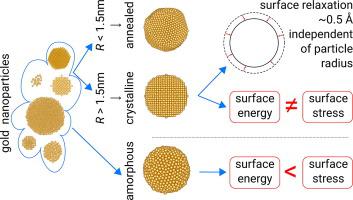International Journal of Solids and Structures ( IF 3.4 ) Pub Date : 2021-04-01 , DOI: 10.1016/j.ijsolstr.2021.111044 David Holec , Lukas Löfler , Gerald A. Zickler , Dieter Vollath , Franz Dieter Fischer

|
The surface energy has been one of the topics of atomistic research for nanoparticles in the last decades. However, the physical role of surface stress and its quantification have been a lot less an object of research. Assumptions for the surface stress, going back to the thermodynamic basis of continua, have been popular. As an example the surface stress (state) follows as derivatives of the surface energy with a rather “classical” evolution equation for the deformation energy. The current concept introduces a combination of atomistic modelling and continuum mechanics for a core–shell system. Considering crystalline and amorphous gold nanoparticles with radii in the range of 1 nm to 12 nm, we are finally able to independently calculate the values of surface stress and surface energy, both slightly decreasing with the increasing particle radius. Surprisingly large values of surface stress are predicted for the case of amorphous nanoparticles.
中文翻译:

再谈金纳米颗粒的表面应力
在过去的几十年中,表面能一直是纳米颗粒原子研究的主题之一。然而,表面应力的物理作用及其量化已经成为研究的对象。可以追溯到连续性的热力学基础的表面应力的假设已广为流行。例如,表面应力(状态)作为表面能的导数,带有一个相当“经典的”变形能的演化方程。当前的概念引入了原子-建模和连续体力学相结合的核-壳系统。考虑到半径在1 nm到12 nm范围内的晶体和无定形金纳米颗粒,我们最终能够独立计算表面应力和表面能的值,两者随颗粒半径的增加而略有减小。











































 京公网安备 11010802027423号
京公网安备 11010802027423号